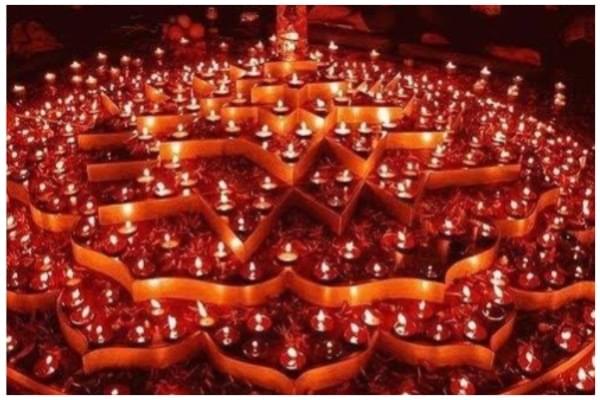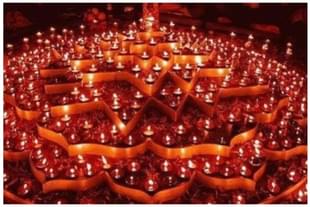Culture
May We Ever Celebrate Thirukarthikkai With The Same Fervour!
Aravindan Neelakandan
Nov 26, 2023, 04:12 PM | Updated 04:12 PM IST
Save & read from anywhere!
Bookmark stories for easy access on any device or the Swarajya app.


Shiva has five faces. They are Sadyojatha, Vamadeva, Aghora, Tatpurusha and Ishana.
When Shiva is Sadashiva these five faces are seen. They are related to the five archetypal functions which manifest as creation, protective sustaining, withdrawal into the root forms, veiling the real essence and providing grace and liberation. These are the five archetypal functions in the Hindu worldview. They are called 'Pancha-kritya'. Ishana faces upwards, Tatpurusha faces east, Aghora faces south, Vamadeva faces north and Sadyojata faces West.
But there is an unmanifest face. It is contained within Shiva as His most subtle essence. It is Adhomukha. It is hence the fiercest. It looks downward.
When Devas came to Shiva and told Him the suffering they were having at the hand of the three Asura brothers, the eldest Soora Padman, Shiva became intense. Along with His five faces the sixth face also came out. From all the six faces emerged six sparks of divine fire. They were given to Agni who could not hold them. He dropped them in a small Himalayan water body, Saravanam, and thus was born the six babies.
The six maidens of Krittika constellation Siva, Sambhuti, Priti, Sannati, Anasuya, and Kshama descended from the skies and nurtured the six divine children.
Then Goddess Parvati came and united all the six children into One. Still He is the child of the six Krittika maidens and hence He is called Kartikeya. When the Krittika Natchatra day comes in the month of Krittika, that night is the celebration of the six mothers who nurtured Murugan.
What an irrational story, they say. Shiva with five faces and then a sixth face and the fire coming from his faces, etc. In fact, the Dravidar Kazhagam in one of its rallies even had an exhibit showing the semen of Shiva emanating from his head, etc. 'The West had shed its mythology' one of their leaders in the rally said. 'Their gods are now in museum'. 'They worship now only one God. We want the same here', he said.
The term 'mythology' emerged in the West in the 15th Century. However, Hindu civilization had long embraced the Purana as a distinct genre which served as a comprehensive guide for seekers, delving into the realms of the psyche through storytelling. Pseudo-rationalism, born out of colonialism and prejudice, inadequately attempts to interpret the profound system of Puranas, ultimately failing.
Puranas are also bold explorations into all aspects of psyche, including some of its darkest. But then it harmonises the dark and the light in the Divine.
Let us take the above Puranic narration of Adhomukha.
Adhomukha is the fierce subtle face of Shiva, so fierce that even the Goddess found its fierceness intimidating. Thirumoolar, the Tamil mystic, narrates some very important characters and Puranic incidents related to Adhomukha.
When the Devas came to Siva and spoke to Him of the tyranny of the Asura, the Self Divine Siva told the precious coral-cued Six-headed God to kill the Asura.Thirumanthiram [520]
Then he explains the source of this sixth face:
This sixth face which is Adhomukha of Siva is the face whose neck has been turned blue and those who take the literal meaning of Siva the Lord wearing the garland of white skulls and spreading the matted hair in all directions, as having drunk the poison, know not the Truth.Thirumanthiram [521]
The poison is that which arises from the churning of the divine ocean. Churning of the ocean or samudra manthan is again an archetypal term in Hindu Puranic language. Here the Axis Mundi of the cosmos and the cosmic serpent are used by both Devas and Asuras to churn the celestial ocean in order to get the amrita. And what emerges first is the poison.
Clearly this is a yogic process in sadhana. When one sets himself or herself on the path of a seeker, the person has to deal with the poisons that the churning throw out before the nectar is obtained. It is only the Divine whose fierce compassion that consumes this poison.
Then Moolar brings out the fact that all vital processes associated with pancha-krityas get energized by Adhomukha:
The primordial One who with the downward Adhomukha manifested the existence, and through Adhomukha He nurtures all life, Adhomukha the Sakthi with the lotus eyes, Adhomukha Lord brings the cosmic dissolution too.Thirumanthiram [524]
Then he proceeds to explain the mystery of Adhomukha:
Listen how Adhomukha became the flowering of the flower most expansive. Transforming itself into hundreds of material realms, Adhomukha is the limitless energy. And the Primordial One as Adhomukha is within Himself thus supporting all that exists.Thirumanthiram [525]
It is now clear that the fierceness and the limitless energy of this face is the defining character of Murugan. The emergence of Adhomukha and the God with Six-heads emanating from this is an act of supreme compassion.
That the emergence of Murugan is an act of supreme compassion is also pointed out by Kachiyappa Sivachariar, who when describing the advent of Murugan in his Tamil version of Kantha-Puranam points out:
The invisible formless takes a visible form, the Beginning-less, the Many and the One, the very radiant flame that is Brahman, assumes a divine body which now has six heads exuding endless compassion and twelve hands and thus has come one Murugan auspicious.
In ancient Sangam literature, in Thirumurukaatrupadai, the poet-seer Nakeeran points out that Murugan in His nebulous form was first given to Agni but Agni could not hold Him for long. The fire of Brahman is unbearable for the fire of Agni – the physical and ceremonial fire. He had to leave it in the Himalayan Saravana Poigai. There the six maidens took charge. Nakeeran calls Murugan as One who was borne by the six Krittikas. They are the wives of the Sapta Rishis, except Arundhati.
The Krittika maidens, by nurturing the Divine, are remembered. On their day, a Thiruvannamalai Deepam is lit. Although Vaisakam is the birth of Murugan, it is Karthikai that is celebrated with far more pomp and splendour in Tamil Nadu. The foster mothers they may be. Compared to Arundhati they might not be considered as perfect as her. But they are celebrated. It is through them that Murugan gets venerated today in every diya lit in Tamil Nadu.
This Puranic narrative is the celebration of the Feminine and is the highest mystic wisdom decentralised and democratised for all. This is our pride. To preserve this, our ancestors faced countless invasions and tortures.
The builders of Hindu civilization associated the Puranic elements with the cycles of astronomical times and sacred geography. Puranas form the vital link between the inner and the outer for a seeker. Every Hindu celebration is a re-assertion of that link.





